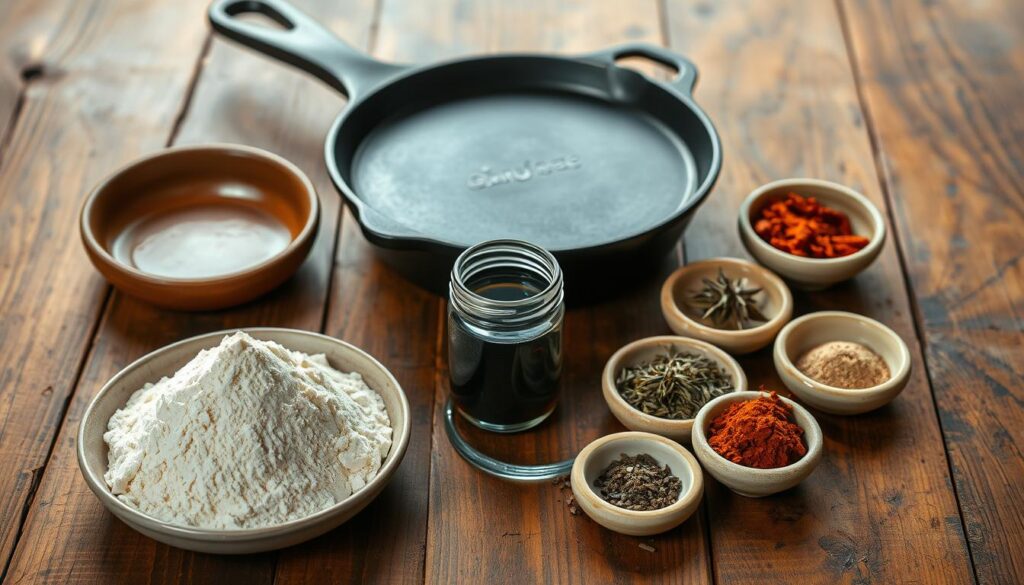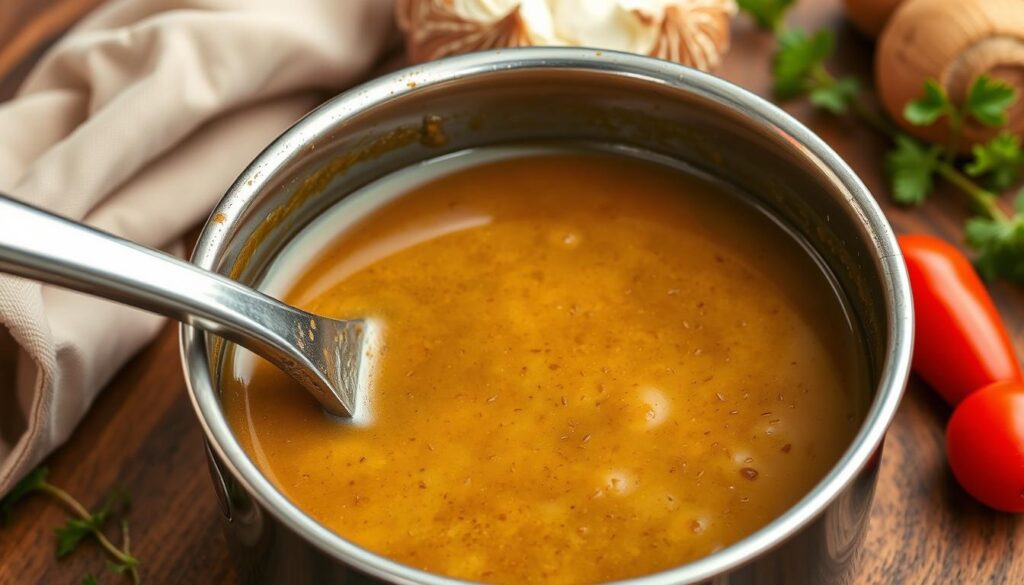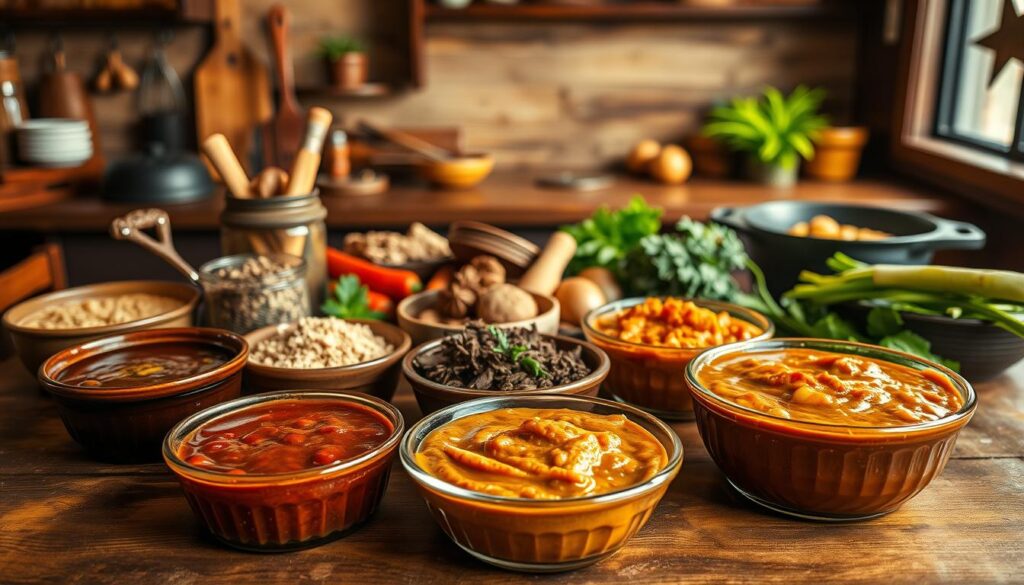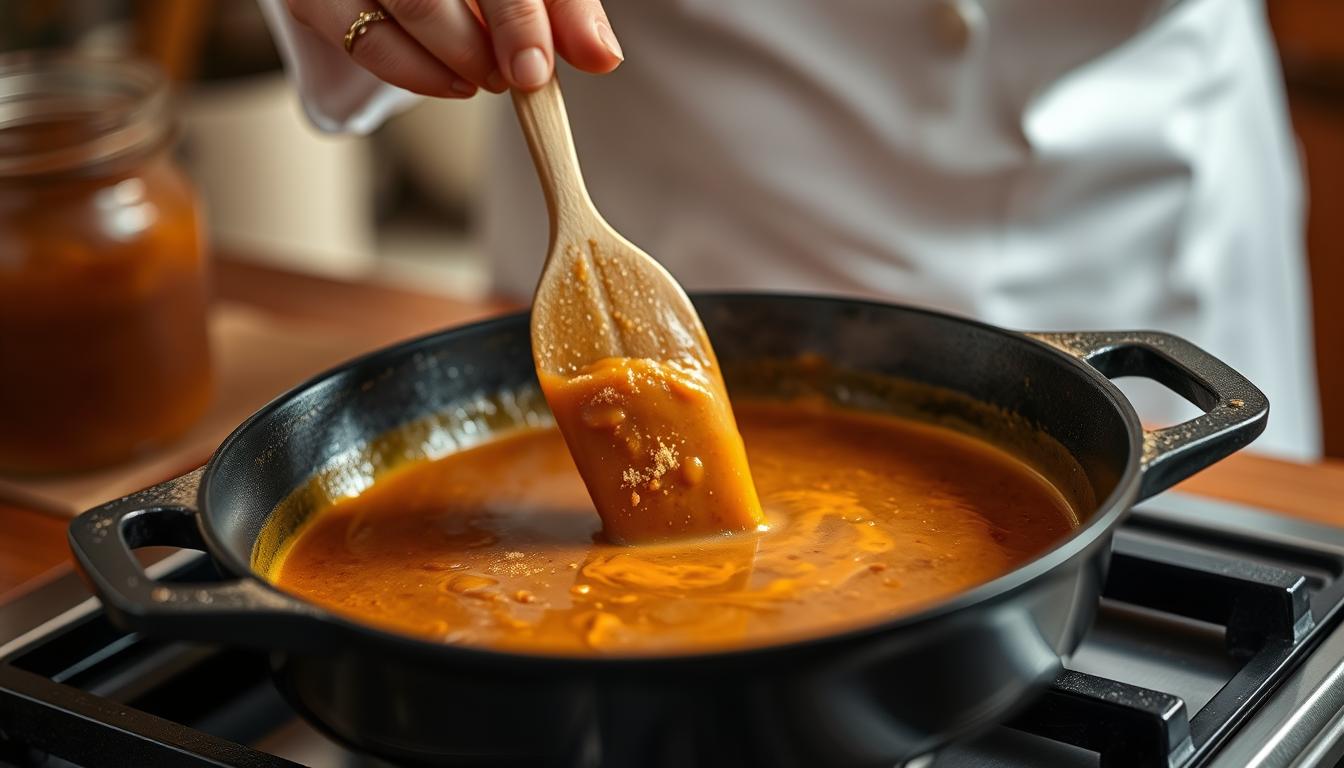The smell of Cajun roux takes me back to my grandmother’s kitchen in Louisiana. It was a place where cooking was a family tradition. Every time I make homemade Cajun Roux, I remember those special moments with her.
Making an authentic Cajun Roux is more than cooking. It’s telling stories through flavors. This basic technique is key to many Southern dishes, making simple ingredients into amazing meals. Whether you’re a pro chef or just starting, learning to make roux will improve your cooking.
A Cajun roux is just flour and fat cooked until it’s dark and rich. The magic is in the stirring and watching it change. With patience and practice, you’ll make a roux that brings depth to your Cajun dishes.
In this guide, we’ll cover everything you need to know about making the perfect homemade Cajun Roux. You’ll learn from the basics to mastering the technique. Soon, you’ll be cooking like a true Louisiana chef. Get ready to discover the secrets of this essential cooking skill!
What is Cajun Roux?
Explore the essence of Cajun cooking and uncover the secret ingredient that elevates simple dishes to new heights. Cajun roux is a key technique that adds depth, richness, and authentic taste to Southern cuisine.
Making Cajun Roux is an art that has been passed down through generations in Louisiana. It’s a mix of flour and fat that forms the base for many dishes, like the beloved gumbo.
The Origins of Roux
The roots of authentic Cajun Roux go back to French cooking traditions. French settlers brought this method to Louisiana, where Cajun cooks made it their own. Learning to make the perfect roux became a defining skill in Cajun cuisine.
- French culinary technique adapted by Cajun cooks
- Originated as a thickening method for sauces and stews
- Evolved into a flavor-building cornerstone of Southern cooking
Importance in Cajun Cuisine
Roux is more than a cooking method; it’s the heart of Cajun dishes. Browning flour in fat creates a unique flavor that can’t be matched by other methods. Each step of cooking reveals different tastes:
| Roux Color | Cooking Time | Flavor Profile |
|---|---|---|
| White Roux | 3-5 minutes | Neutral, mild |
| Blonde Roux | 10-15 minutes | Buttery, light |
| Dark Roux | 25-30 minutes | Rich, nutty, intense |
Pro tip: The longer you cook your roux, the richer the flavor gets. A dark chocolate-colored roux is the sign of a true Cajun gumbo.
Essential Ingredients for Cajun Roux
Making a perfect Cajun roux from scratch is all about the ingredients. The right mix of ingredients turns your dish into a true Cajun delight.

To make Cajun Roux, focus on flour, fat, and flavor enhancers. Each one is key to the rich taste of Cajun cooking.
Flour Choices for Your Roux
Choosing the right flour is the first step. For traditional Cajun roux, all-purpose flour is best. You can also use:
- All-purpose white flour
- Gluten-free alternatives like rice flour
- Whole wheat flour for a nuttier flavor
Types of Fat to Consider
Choosing the right fat is important when making Cajun roux from scratch. Different fats give different flavors:
| Fat Type | Flavor Profile | Best Used For |
|---|---|---|
| Vegetable Oil | Neutral | Classic roux base |
| Lard | Rich, meaty | Traditional gumbo |
| Bacon Fat | Smoky | Hearty dishes |
| Butter | Creamy | Lighter sauces |
Additional Flavor Enhancers
To make your Cajun Roux even better, add some extra flavor:
- Garlic powder for depth
- Cayenne pepper for heat
- Onion powder for sweetness
Remember, making a great roux takes patience and care. Each ingredient adds to the flavor. Choose well and cook with love!
The Perfect Ratios for Roux
Making the best Cajun Roux recipe begins with knowing the right mix of ingredients. The key to a great roux is the fat to flour ratio. This ratio affects the color, taste, and thickness of your dish.
The classic Cajun Roux starts with a 1:1 fat to flour mix. This simple ratio is the foundation for many Louisiana favorites.
Color Spectrum of Roux
The magic of roux comes from careful cooking and color changes. Each stage adds a special flavor to your dish:
- White Roux: Light tan, cooked for 2-5 minutes
- Blond Roux: Peanut butter color, cooked for 5-10 minutes
- Brown Roux: Milk chocolate tone, cooked for 15-30 minutes
- Dark Brown Roux: Rich, complex flavor, cooked for 30-45 minutes
Ratio Variations for Perfect Texture
For a deeper, richer dark brown roux, try adjusting the ratio. Adding more flour, about 25%, can make your Cajun dishes more intense.
| Roux Type | Fat (Cups) | Flour (Cups) | Cooking Time |
|---|---|---|---|
| Light Roux | 1 | 1 | 2-5 minutes |
| Dark Roux | 1 | 1.25 | 30-45 minutes |
Mastering Cajun Roux steps requires patience and focus. Your perfect roux is just around the corner!
Step-by-Step Guide to Making Roux
Making the perfect Cajun Roux guide needs patience and precision. It’s an art that turns simple ingredients into a rich base for many dishes.

First, get your tools ready. You’ll need a heavy-bottomed cast-iron skillet or Dutch oven, a long-handled whisk, and focus.
Heat and Fat Combination
Start by picking the right fat. While butter is traditional, oil gives better results. Choose from:
- Vegetable oil
- Canola oil
- Peanut oil
Heat your fat over medium-low heat. Keep the temperature between 225-250°F for the best results.
Adding the Flour
Slowly whisk in all-purpose flour, keeping a 1:1 ratio by weight. For 2 ounces of fat, use 2 ounces of flour. Stir constantly to avoid burning and ensure smooth mixing.
Achieving the Desired Color
The color of your roux affects its flavor. Cooking times vary:
- White roux: 2-5 minutes
- Blond roux: 5-10 minutes
- Brown roux: 15-30 minutes
- Dark brown roux: 30-45 minutes
Watch for color changes and avoid burning. A dark brown roux gives the richest flavor, perfect for gumbo.
Common Mistakes to Avoid
Making an authentic Cajun Roux recipe needs patience and focus. Many home cooks make mistakes that can ruin their dish. Knowing these common errors will help you get better at perfect roux preparation.
The Dangers of Overcooking
Overcooking your Cajun Roux can turn it into a bitter, burnt mess. It’s important to watch it closely. Never leave your roux unattended. If you see dark spots or burning, start over right away.
- Watch the color carefully
- Stir continuously
- Use medium-low heat
- Remove from heat if burning begins
Selecting the Right Fat
Choosing the wrong fat can change your Cajun Roux’s taste. Different fats have their own smoke points and tastes that affect the dish.
- Butter: Creates lighter, more delicate flavor
- Vegetable oil: Provides neutral base
- Bacon fat: Adds rich, smoky undertones
- Avoid oils with low smoke points
Learning these techniques will make your Cajun Roux recipe amazing. Remember, practice, patience, and attention to detail are key.
Using Your Roux in Cajun Dishes
Learning to make homemade Cajun Roux opens up a world of tasty possibilities. Your homemade Cajun Roux is the key to making traditional Southern dishes stand out. It turns simple meals into unforgettable experiences.

Roux is the heart of many Cajun classics. Its deep flavor makes any dish go from good to great. With a little care, you can make any meal special.
Classic Cajun Dishes with Roux
Your homemade Cajun Roux is perfect for these traditional recipes:
- Gumbo: The quintessential Cajun stew that depends entirely on a perfect roux
- Jambalaya: A rich, hearty rice dish with deep flavor layers
- Étouffée: A succulent seafood or chicken dish with intense depth
Sauces and Soups
Cajun Roux from scratch is great for more than just main dishes. It’s perfect for:
- Thick, velvety sauces
- Hearty vegetable soups
- Rich gravies
| Dish Type | Roux Color | Recommended Use |
|---|---|---|
| Chicken Dishes | Medium Brown | Light to medium roux |
| Seafood Gumbo | Dark Brown | Deep, rich roux |
| Vegetable Stews | Blonde | Light roux |
Professional chefs say making roux takes patience. It’s about letting it develop flavors that will take your cooking to new levels.
Storage Tips for Leftover Roux
Keeping your homemade Cajun Roux recipe fresh is key. It helps keep the flavor rich and ready for future meals. Knowing how to store leftover roux saves time and effort.
Storing your roux properly is important. Here are some tips to keep it fresh for your next dish:
- Always cool the roux completely before storing
- Use an airtight container to prevent moisture and contamination
- Label the container with the date of preparation
Refrigeration Techniques
The fridge is great for storing roux. When you make the best Cajun Roux recipe, you can keep it in the fridge for up to a week. For longer, freeze it.
Freezing Your Roux
Freezing is a good way to keep your roux for a long time. Here’s a guide:
| Storage Method | Duration | Recommended Technique |
|---|---|---|
| Refrigerator Storage | Up to 1 week | Airtight container |
| Freezer Storage | Up to 6 months | Freeze in ice cube trays |
Pro tip: Freeze your roux in small portions using ice cube trays. This method lets you thaw just what you need for your next dish. Just pop out a cube when you’re ready to cook!
Signs of Spoilage
Always check your stored roux before using it. If it smells bad, looks different, or has mold, throw it away. Fresh roux is key for making great Cajun dishes.
Creative Variations on Traditional Roux
Exploring new Cajun roux ingredients can make your cooking stand out. Traditional roux is great, but you can also try new flavors and ways to make it.

Trying new things with Cajun roux can lead to amazing dishes. You don’t have to stick to the usual ingredients. Being creative can make this basic cooking method truly special.
Spice Exploration in Roux
Adding spices to your roux can add amazing flavors. Here are some spice ideas to try:
- Smoked paprika for a rich, earthy taste
- Cayenne pepper for that Cajun kick
- Herbs de Provence for a Mediterranean flair
- Dried thyme and oregano for extra depth
Alternative Fat Selections
While vegetable oil is common in roux, other fats can change your dish a lot:
| Fat Type | Flavor Profile | Best Used With |
|---|---|---|
| Duck Fat | Rich, luxurious | Darker roux dishes |
| Clarified Butter | Nutty, smooth | Light-colored roux |
| Bacon Grease | Smoky, intense | Hearty meat-based recipes |
Choosing the right fat is key when making Cajun roux. It affects the taste and texture of your dish. So, experiment and find your own style!
Cooking Techniques for Roux
Mastering the art of creating an authentic Cajun Roux requires understanding different cooking techniques. Your Cajun Roux guide will explore two primary methods: stovetop and oven-baked approaches. These methods bring unique characteristics to this foundational cooking technique.
Learning to create the perfect roux involves patience and practice. Whether you’re a home cook or aspiring chef, these techniques will help you develop a rich, flavorful base for traditional Cajun dishes.
Stovetop Roux Mastery
The stovetop method remains the most traditional approach for creating a Cajun Roux. Here are key steps to success:
- Use a heavy-bottomed cast-iron skillet
- Maintain medium-low heat
- Stir continuously to prevent burning
- Watch for color changes carefully
Oven-Baked Roux Technique
An alternative method for creating an authentic Cajun Roux involves oven baking. This method offers more consistent results with less active stirring.
| Cooking Method | Time | Effort Level |
|---|---|---|
| Stovetop | 20-45 minutes | High (constant stirring) |
| Oven-Baked | 2-2.5 hours | Low (occasional stirring) |
For oven-baked roux, set your temperature to 350°F and stir every 20 minutes. This method allows for a more hands-off approach while developing deep, complex flavors.
Whichever technique you choose, remember that creating the perfect Cajun Roux is an art form. It requires practice and attention to detail.
Cajun Roux and Dietary Considerations
Making a tasty homemade Cajun Roux recipe is easy, even with dietary limits. Traditional roux uses wheat flour, but you can swap it for other options. This way, everyone can enjoy the rich Cajun flavors.
If you can’t have gluten, rice flour is a great choice. Just replace wheat flour with rice flour in your Cajun Roux recipe. Cornstarch or almond flour also work well for thickening.
Vegetarians and vegans can make roux too. Use coconut oil, vegetable shortening, or olive oil instead of animal fats. Just keep the fat and flour ratio the same and try different ingredients.
Changing your homemade Cajun Roux might take some tries. Don’t worry if it’s not perfect at first. Every batch is a chance to get better and make a roux that’s both healthy and delicious.

